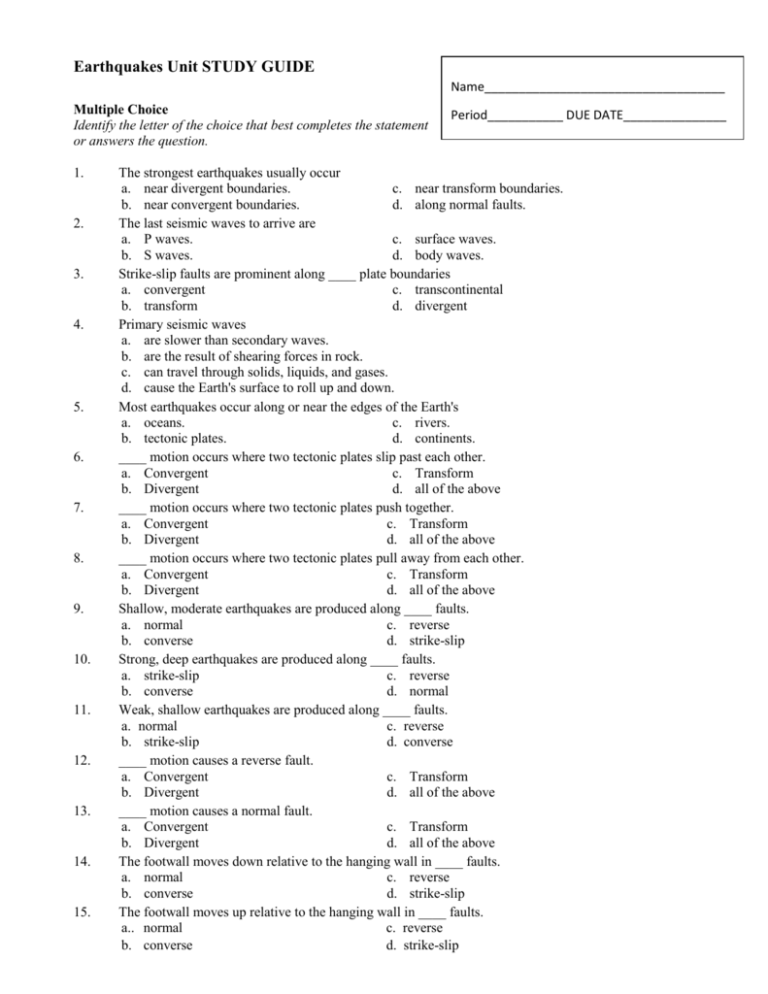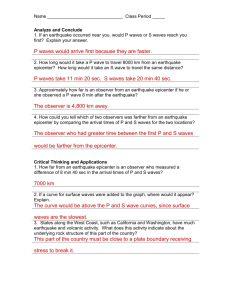Earthquakes Unit STUDY GUIDE
advertisement

Earthquakes Unit STUDY GUIDE Name___________________________________ Multiple Choice Identify the letter of the choice that best completes the statement or answers the question. 1. 2. 3. 4. 5. 6. 7. 8. 9. 10. 11. 12. 13. 14. 15. Period___________ DUE DATE_______________ The strongest earthquakes usually occur a. near divergent boundaries. c. near transform boundaries. b. near convergent boundaries. d. along normal faults. The last seismic waves to arrive are a. P waves. c. surface waves. b. S waves. d. body waves. Strike-slip faults are prominent along ____ plate boundaries a. convergent c. transcontinental b. transform d. divergent Primary seismic waves a. are slower than secondary waves. b. are the result of shearing forces in rock. c. can travel through solids, liquids, and gases. d. cause the Earth's surface to roll up and down. Most earthquakes occur along or near the edges of the Earth's a. oceans. c. rivers. b. tectonic plates. d. continents. ____ motion occurs where two tectonic plates slip past each other. a. Convergent c. Transform b. Divergent d. all of the above ____ motion occurs where two tectonic plates push together. a. Convergent c. Transform b. Divergent d. all of the above ____ motion occurs where two tectonic plates pull away from each other. a. Convergent c. Transform b. Divergent d. all of the above Shallow, moderate earthquakes are produced along ____ faults. a. normal c. reverse b. converse d. strike-slip Strong, deep earthquakes are produced along ____ faults. a. strike-slip c. reverse b. converse d. normal Weak, shallow earthquakes are produced along ____ faults. a. normal c. reverse b. strike-slip d. converse ____ motion causes a reverse fault. a. Convergent c. Transform b. Divergent d. all of the above ____ motion causes a normal fault. a. Convergent c. Transform b. Divergent d. all of the above The footwall moves down relative to the hanging wall in ____ faults. a. normal c. reverse b. converse d. strike-slip The footwall moves up relative to the hanging wall in ____ faults. a.. normal c. reverse b. converse d. strike-slip 16. 17. 18. 19. 20. 21. P waves and S waves are two types of ____ waves. a. interior c. surface b. exterior d. body Which type of seismic wave travels the fastest? a. an L wave c. an S wave b. a P wave d. a surface wave Which type of seismic wave can travel through solids, liquids, and gases? a. an L wave c. an S wave b. a P wave d. a surface wave Which type of seismic wave cannot travel through liquids? a. an L wave c. an S wave b. a P wave d. a surface wave Which type of seismic wave travels the slowest? a. an L wave c. an S wave b. a P wave d. a surface wave Which type of seismic wave is the most destructive? a. an L wave c. an S wave b. a P wave d. a surface wave Examine the illustration below and answer the questions that follow. 22. 23. 24. 25. 26. 27. Which point in the illustration represents the epicenter of the earthquake? a. point A c. point C b. point B d. point D Which point in the illustration represents the focus of the earthquake? a. point A c. point C b. point B d. point D The Richter scale is used to measure the a. length of time an earthquake lasts. c. strength of an earthquake. b. the epicenter of an earthquake. d. depth of an earthquake's focus. Which area of the United States has the highest earthquake hazard level? a. the East Coast c. the West Coast b. the Gulf Coast d. the Midwest The ____ marks the boundary between the Earth's crust and mantle, where the speed of seismic waves increases sharply. a. Moho c. shadow zone b. seismic gap d. subduction zone The ____ is an area on the Earth's surface where no direct seismic waves from a particular earthquake can be detected. a. Moho c. shadow zone b. seismic gap d. subduction zone Examine the table below, and answer the questions that follow. (Based on Observations Since 1900) 28. 29. 30. 31. 32. 33. 34. 35. 36. 37. According to the table, earthquakes that register between 6.0 and 6.9 on the Richter scale occur approximately ____ times a year worldwide. a. 18 c. 800 b. 120 d. 6,200 How often does an earthquake measuring 8.2 on the Richter scale, such as the one in Bolivia in 1994, occur worldwide? a. once every ten years c. twice a year b. once a year d. eight times a year A break in Earth’s crust along which blocks of crust slide relative to one another is a. a plate. c. a fault. b. a deformation. d. an earthquake. Another word for an earthquake’s strength is its a. magnitude. c. epicenter. b. intensity. d. focus. What kind of deformation leads to earthquakes? a. plastic deformation c. convergent deformation b. elastic deformation d. shear deformation The epicenter of an earthquake is the point on Earth’s surface a. directly below the focus. c. above the seismic gap. b. directly above the earthquake’s focus. d. where the damage is lightest. The strength of an earthquake is determined by the a. type of fault on which it occurs. c. amount of damage it causes. b. gap hypothesis. d. amount of ground motion. A measure of how likely an area is to experience an earthquake is its a. earthquake-zone level. c. seismic-gap level. b. Mercalli-intensity level. d. earthquake-hazard level. Strike-slip faults are created by a. convergent motion. c. transcontinental motion. b. transform motion. d. divergent motion. What is the science in which earthquakes are studied called? a. earthquake science c. seismology b. tectonics d. wave science 38. What is the degree to which people feel an earthquake and how much damage it causes called? a. intensity c. magnitude b. richter d. frequency Completion Complete each sentence or statement. 39. 40. Energy is released as _________________________ occurs. (deformation or elastic rebound) ____________________ cannot travel through parts of the Earth that are completely liquid. (S waves or P waves) 41. The ____________________ is a place that marks a sharp increase in seismic wave speed. (seismic gap or Moho) 42. The ____________________ of an earthquake may be far below the Earth's surface. (epicenter or focus) 43. When stress increases along faults, rock ____________________ occurs which in turn can lead to earthquakes. 44. Transform motion creates ____________________ faults. 45. The type of body wave that can move through any substance is a(n) ____________________. Use the terms from the following list to complete the sentences below. surface waves P waves S waves body waves 47. The fastest seismic waves are ____________________. 48. Waves of energy that travel through the inside of Earth are called ____________________. 49. The waves that cannot travel through liquids are ____________________. 50. The most destructive seismic waves are ____________________. Matching Match each item with the correct statement. a. seismogram b. epicenter c. focus ____ 51. ____ ____ ____ ____ ____ 52. 53. 54. 55. 56. d. seismograph e. Richter magnitude scale f. Modified Mercalli Intensity Scale instrument that records vibrations in the ground and determines the location and strength of an earthquake tracing of earthquake motion that is created by a seismograph scale used to measure earthquake damage point along a fault at which the first motion of an earthquake occurs point on Earth’s surface directly above an earthquake’s starting point scale used to measure earthquake strength







